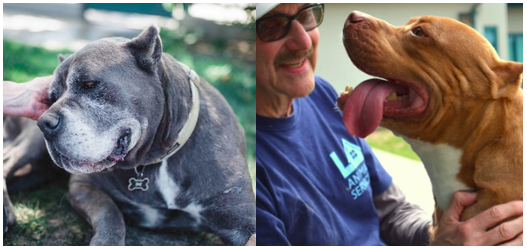NC BUDGET ADVOCATES--After many years in which thousands of animals were killed in our City shelters for lack of space, the City has finally reached No-Kill for dogs.
This is a monumental achievement, for which Los Angeles Animal Services Department, the City Council, the Mayor, and the entire City can be very proud. But this accomplishment will be jeopardized if there is insufficient funding for spay/neuter programs -- the shelters will once again be killing dogs for lack of space. And the City has not yet gotten to No-Kill for cats.
This is the first in a series of articles on the Los Angeles Animal Services Department, its budget, and its No-Kill goal. Note Photos above: Cleo, left, killed for lack of space in 2015; King, right, killed for lack of space in 2017.
The Los Angeles Animal Services Department (LAAS) is one of the largest municipal animal shelter systems in the country, charged with promoting and protecting the health, safety, and welfare of the animals and people of the City. LAAS runs the six City animal shelters, serving approximately 60,000 animals each year, and responds to approximately 20,000 emergency calls involving animals or persons in danger. For many years, a primary goal of LAAS has been to make the City shelters No-Kill.
The Neighborhood Council Budget Advocates are an elected, all volunteer, independent advisory body of the City government charged with making constructive recommendations on the City’s budget to the Mayor and City Council and working with City Departments to improve their operations. Pursuant to its responsibilities, the Budget Advocates met with the General Manager and Assistant General Managers of LAAS on November 2, 2018.
For the current fiscal year 2018-19, the LAAS budget is approximately $24.5 million, out of a total City budget of $9.8 billion. This is approximately one quarter of one percent of the total City budget, for the protection and care of all animals in the City, including operation of the six City animal shelters. (This does not include pension and benefit costs, which are separately funded.)
Both the Mayor and the City Council have made the achievement and maintenance of No-Kill a high priority for the City. (See City Council File 17-0170.) The City’s No-Kill policy is of utmost importance to many citizens of the City, including those patronizing the City shelters. No healthy adoptable animals should be killed in our City shelters for lack of kennel space. In order to achieve that goal, and provide humane treatment for the increasing number of animals in the City shelters, the LAAS budget should be modestly increased in three areas:
- To Achieve and Maintain No-Kill.
- To Increase Volunteer Support for the Shelters.
- To Provide Adequate Staffing.
This article will discuss the progress LAAS has made toward making Los Angeles a No-Kill City.
Mandated Spay/Neuter. Funding spay/neuter of dogs, cats, and rabbits is key to achieving and maintaining No-Kill in the City shelters. Spay/neuter also saves the City a tremendous amount of money in the long run. It is much less expensive to spay/neuter dogs, cats, and rabbits than it is to care for generations of offspring of those animals at the City shelters and ultimately have to put them to death when the shelters run out of space for them.
Prior to 2015, $1.1 million was transferred annually from the City’s General Fund to the Animal Sterilization Fund, which is administered by LAAS to be used for spay/neuter of animals owned by low-income pet owners in the City. This amount was decreased to $500,000 in 2015-16, and then was cut entirely in 2016-17 and 2017-18. The Animal Sterilization Fund was about to run out of money, which would have eliminated spay/neuter services for low-income pet owners, until the City Council (led by Councilmembers Blumenfield and Koretz) provided $850,000 to the fund in May 2018.
After many years in which thousands of animals were killed in our City shelters for lack of space, the City has finally reached No-Kill for dogs. (Above 90% live/save rate is generally considered “No-Kill.” The remaining 10%, unfortunately, accounts for dogs and cats who are too sick or injured to be saved, or dogs who are too aggressive to be safely adopted or rescued.)
This is a monumental achievement, for which LAAS, City Council, the Mayor, and the entire City can be very proud. The live/save rate for dogs at the six Los Angeles City shelters was 93.36% for 2018. (The live/save rate is (live impounds minus non-live outcomes) divided by live impounds.) This live/save rate was reached in large part because of the annual $1.1 million funding of the Animal Sterilization Fund in past years, but this will be jeopardized if the Animal Sterilization Fund is depleted. Decreasing the numbers of dogs through funded spay/neuter programs is the basis for continuing the City’s success in achieving and maintaining No-Kill. If spay/neuters decrease, in a few years, the shelters will once again be killing dogs for lack of space.
Los Angeles has not yet achieved No-Kill for cats. This will be discussed in the next article.
In addition to the fact that spaying and neutering animals is more humane than killing them, housing and killing animals born from un-neutered animals will cost the City much more than the front-end solution of providing additional funds for the Animal Sterilization Fund. Furthermore, it will reflect poorly on the City to have achieved No-Kill for dogs, and then lose that status simply because of lack of funding for spay/neuter.
Later articles in CityWatch will detail the conclusions and recommendations the Budget Advocates reached to achieve and maintain No-Kill, as well as to increase volunteer support for the shelters and staffing.
(Jeffrey Mausner is a Neighborhood Council Budget Advocate, 2nd Vice President of the Tarzana Neighborhood Council and Chair of its Animal Welfare Committee, Neighborhood Councils Liaison to the L.A. Animal Services Department, and a Volunteer at the West Valley Animal Shelter. He is a retired attorney and law school professor and was formerly a Federal Prosecutor for the U.S. Justice Department.














